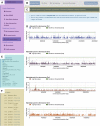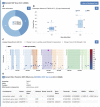easyGWAS: A Cloud-Based Platform for Comparing the Results of Genome-Wide Association Studies
- PMID: 27986896
- PMCID: PMC5304348
- DOI: 10.1105/tpc.16.00551
easyGWAS: A Cloud-Based Platform for Comparing the Results of Genome-Wide Association Studies
Abstract
The ever-growing availability of high-quality genotypes for a multitude of species has enabled researchers to explore the underlying genetic architecture of complex phenotypes at an unprecedented level of detail using genome-wide association studies (GWAS). The systematic comparison of results obtained from GWAS of different traits opens up new possibilities, including the analysis of pleiotropic effects. Other advantages that result from the integration of multiple GWAS are the ability to replicate GWAS signals and to increase statistical power to detect such signals through meta-analyses. In order to facilitate the simple comparison of GWAS results, we present easyGWAS, a powerful, species-independent online resource for computing, storing, sharing, annotating, and comparing GWAS. The easyGWAS tool supports multiple species, the uploading of private genotype data and summary statistics of existing GWAS, as well as advanced methods for comparing GWAS results across different experiments and data sets in an interactive and user-friendly interface. easyGWAS is also a public data repository for GWAS data and summary statistics and already includes published data and results from several major GWAS. We demonstrate the potential of easyGWAS with a case study of the model organism Arabidopsis thaliana, using flowering and growth-related traits.
© 2016 American Society of Plant Biologists. All rights reserved.
Figures






References
-
- Abdi H. (2007). The Bonferonni and Šidák corrections for multiple comparisons. Encycl. Meas. Stat. 3: 103–107.
-
- Aho K., Derryberry D., Peterson T. (2014). Model selection for ecologists: the worldviews of AIC and BIC. Ecology 95: 631–636. - PubMed
-
- Andreassen O.A., et al. ;. International Consortium for Blood Pressure GWAS; Diabetes Genetics Replication and Meta-analysis Consortium; Psychiatric Genomics Consortium Schizophrenia Working Group (2013). Improved detection of common variants associated with schizophrenia by leveraging pleiotropy with cardiovascular-disease risk factors. Am. J. Hum. Genet. 92: 197–209. - PMC - PubMed
-
- Ariel F., Jegu T., Latrasse D., Romero-Barrios N., Christ A., Benhamed M., Crespi M. (2014). Noncoding transcription by alternative RNA polymerases dynamically regulates an auxin-driven chromatin loop. Mol. Cell 55: 383–396. - PubMed
Publication types
MeSH terms
LinkOut - more resources
Full Text Sources
Other Literature Sources

